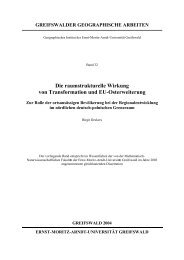Sustainability of sand dune restoration along the coast of ... - BioOne
Sustainability of sand dune restoration along the coast of ... - BioOne
Sustainability of sand dune restoration along the coast of ... - BioOne
Create successful ePaper yourself
Turn your PDF publications into a flip-book with our unique Google optimized e-Paper software.
96 De Lillis, M. et al.<br />
Fig. 4. Changes in species richness in <strong>the</strong> four years following<br />
<strong>dune</strong> building-up, from June 1996 to July 2000. The number<br />
and <strong>the</strong> progressive increase <strong>of</strong> <strong>the</strong> species is greatest on <strong>dune</strong>s<br />
stabilized by A. littoralis.<br />
These are autochthonous species, germinated from <strong>the</strong><br />
seeds occurring in <strong>the</strong> <strong>sand</strong> used for building up <strong>the</strong> <strong>dune</strong>s<br />
(Table 2). The two <strong>dune</strong>s where A. littoralis does not<br />
occur show a smaller number <strong>of</strong> species than <strong>the</strong> o<strong>the</strong>rs:<br />
two germinated in June 1997: Cakile maritima and<br />
Raphanus raphanister ssp. landra, and six in July 2000:<br />
Elymus farctus, An<strong>the</strong>mis maritima, Eryngium maritimum,<br />
Cyperus capitatus, Sporobolus pungens and Crucianella<br />
maritima. In June 2001 <strong>the</strong> average number <strong>of</strong> species on<br />
each <strong>dune</strong> belt (Fig. 5) is highest (6.6) at <strong>the</strong> greatest<br />
distance from <strong>the</strong> sea (d > 70 m) and lower in <strong>the</strong> o<strong>the</strong>r<br />
<strong>dune</strong> belts (4.6, d < 40 m; 4.2, 40 m < d < 70 m).<br />
At <strong>the</strong> same time <strong>the</strong> total plant cover varies between<br />
15 and 60% with an average <strong>of</strong> 28.6% (data not shown)<br />
and is composed mainly <strong>of</strong> A. littoralis.<br />
The average cover and <strong>the</strong> frequency <strong>of</strong> <strong>the</strong> species<br />
present in June 2001 are set out in Table 3.<br />
A. littoralis is <strong>the</strong> dominant species with 25% <strong>of</strong> <strong>the</strong><br />
cover; among <strong>the</strong> species that germinate after planting<br />
Ammophila, only An<strong>the</strong>mis maritima, Elymus farctus<br />
and Echynophora spinosa reach fairly high cover values.<br />
The range <strong>of</strong> <strong>the</strong> frequency <strong>of</strong> <strong>the</strong> species, from 3 to<br />
Fig. 5. Average number <strong>of</strong> species on each <strong>dune</strong> belt observed<br />
in June 2001. The largest number occurs more than 70 m from<br />
<strong>the</strong> sea.<br />
90%, is very great: <strong>the</strong>re are species present only on a<br />
few <strong>dune</strong>s (C. maritima, S. kali, S. pungens), whereas<br />
o<strong>the</strong>r species are widely represented (A. maritima, E.<br />
farctus, E. maritimum) .<br />
The morphological characteristics <strong>of</strong> <strong>the</strong> <strong>dune</strong>s, <strong>the</strong><br />
height and <strong>the</strong> surface particularly, show a progressive<br />
change during time. The height decreases progressively<br />
in all <strong>the</strong> three belts (Fig. 6). In July 2000 <strong>the</strong> height <strong>of</strong><br />
<strong>the</strong> <strong>dune</strong>s located more than 70 m from <strong>the</strong> sea is about<br />
60% <strong>of</strong> <strong>the</strong> initial one, that <strong>of</strong> <strong>the</strong> <strong>dune</strong>s closest to <strong>the</strong> sea<br />
was 50%, and that <strong>of</strong> <strong>the</strong> <strong>dune</strong>s located between 40 and<br />
70 m from <strong>the</strong> sea was 49%.<br />
In <strong>the</strong> two control <strong>dune</strong>s, i.e. without A. littoralis, <strong>the</strong><br />
height progressively decreases until July 2000 when it<br />
reaches 47% <strong>of</strong> its initial value; <strong>the</strong> height <strong>of</strong> <strong>the</strong> control<br />
<strong>dune</strong>s is very similar to that <strong>of</strong> <strong>the</strong> <strong>dune</strong>s located in <strong>the</strong><br />
belt < 40 m from <strong>the</strong> sea.<br />
In <strong>the</strong> course <strong>of</strong> time <strong>the</strong> surface area <strong>of</strong> <strong>the</strong> <strong>dune</strong>s<br />
(Fig. 7) tends to increase due to <strong>the</strong> accumulation <strong>of</strong><br />
<strong>sand</strong> at <strong>the</strong> sides <strong>of</strong> each <strong>dune</strong>. The surface area <strong>of</strong> <strong>the</strong><br />
<strong>dune</strong>s at more than 70 m from <strong>the</strong> sea changes from 25<br />
m 2 to 34 m 2 and, similarly, in <strong>the</strong> <strong>dune</strong>s located in <strong>the</strong><br />
Table 2. Floristic list <strong>of</strong> species present in June 1997 and in<br />
July 2000 on <strong>the</strong> 40 <strong>dune</strong>s studied. The number <strong>of</strong> species<br />
increases from 7 to 16 in four years (see also Fig. 4).<br />
Species June 1997 July 2000<br />
An<strong>the</strong>mis maritima + +<br />
Elymus farctus + +<br />
Ononis variegata + +<br />
Eryngium maritimum + +<br />
Cyperus capitatus + +<br />
Echinophora spinosa + +<br />
Cakile maritima + +<br />
Raphanus raphanister ssp. landra + +<br />
Euphorbia peplis + +<br />
Sporobolus pungens + +<br />
Calistegia soldanella +<br />
Xanthium italicum +<br />
Crucianella maritima +<br />
Cutandia maritima +<br />
Salsola kali +<br />
Teucrium polium +<br />
Table 3. Mean cover and frequency <strong>of</strong> species present on <strong>the</strong><br />
40 <strong>dune</strong>s under study in June 2001.<br />
Species Cov. (%) Freq. (%)<br />
Ammophila littoralis 24.5 90.2<br />
An<strong>the</strong>mis maritima 6.46 68.6<br />
Elymus farctus 3.11 57.1<br />
Eryngium maritimum 0.49 37.1<br />
Ononis variegata 0.34 34.3<br />
Euphorbia peplis 1.74 31.4<br />
Echinophora spinosa 2.26 34.3<br />
Cakile maritima 0.86 28.6<br />
Cyperus capitatus 0.14 14.3<br />
Raphanus raphanister ssp. landra 0.31 5.7<br />
Crucianella maritima 0.03 5.7<br />
Calystegia soldanella 0.03 5.7<br />
Xanthium italicum 0.17 5.7<br />
Sporobolus pungens 0.03 2.9<br />
Salsola kali 0.03 2.9<br />
Cutandia maritima 0.03 2.9




